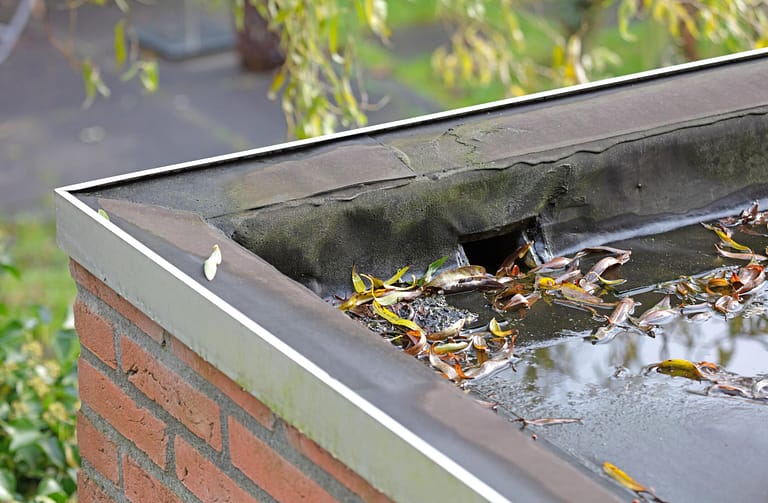
Why spend your money on a new car, a vacation, or art when you can spend it on the most exciting purchase humanly possible: a roof replacement!! 🥳🎊🕺
Okay, we know, we know... roof replacements are definitely not the most exciting purchase you can make. However, they’re pretty much inevitable for most homeowners at some point, so you might as well be prepared!
Not sure if you need to start budgeting for a roof replacement or if you’ve got a few good years left? Learn when to replace your roof by checking out the 6 main indicators below.
1) The Roof Has Reached Its Lifespan ⌛
Perhaps the biggest indicator that you need a new roof is that your current roof has met or exceeded its lifespan. Ideally, you received the year the roof was installed when you bought your home. If not, you can try getting in touch with the listing agent of the home to see if they can connect with the previous owners. You can also look for building permits with your local municipality.

The average lifespans of common roofing materials are as follows:
- Asphalt Shingles (the most common): 15-25 years
- Metal Panels: 40-70 years
- Cedar Shakes: 20-25 years
- Composite Tiles: 20-50 years
- Clay or Concrete Tiles: 75-100 years
- Slate Tiles: 100+ years
If your asphalt shingle roof is approaching 20 years of age, it’s time to start thinking about a replacement. Especially if the age of the roof is combined with any of the issues below.
2) You’re Experiencing Water Damage 💧
An old, damaged, or improperly installed roof is susceptible to leaks. Unfortunately, water damage is problematic and expensive to fix, but if left untouched, it can cause structural damage.
Watch for the following signs of a leaking roof, and if you spot any, call a roofing contractor right away:
- Water stains on the ceiling or walls
- Active dripping water
- Cracks on the ceiling or walls
- Mold growth
- Musty smells
If roof leaks are persistent or can’t be solved with a roof repair, you’ll likely need to get a new roof.
3) The Roof Deck Is Sagging ⬇️

There are many components to a complete roofing system, and the part that holds everything up is the plywood roof decking (or roof sheathing). If the roof deck begins sagging, that means that the wood is rotten. A sagging roof deck indicates structural damage and is not an issue to be taken lightly.
If you notice that your roof has a dip or sag— even if it’s just in one area, you should schedule a professional roof inspection right away, as you might need a full roof replacement. New decking isn’t required for all roof replacements, but when it’s rotten and sagging, you’ll need new plywood as well, which will add to the overall cost of your roof replacement.
4) Mold or Algae Has Taken Over 🌱
Older roofs can trap moisture, and trapped moisture is a playground for algae, mold, moss, and fungi. You may notice little green sprouts growing in between the shingles or tiles on your roof. Or, your roof may have black streaks running down it. If moss or algae growth persists on your roof no matter how often you try to clean it off, then your roof may be past repair.
It’s best to get advice from a professional roofing contractor regarding moss or algae on your roof. There may be underlying problems, and your contractor will be able to come up with a game plan to get your roof back in top condition.
5) Significant Hail, Wind, or Other Storm Damage ⛈️
A nasty storm can negatively impact roofs of all shapes, sizes, and ages. Even a younger roof can meet its match during an intense hail or wind storm, especially if it wasn’t installed correctly in the first place. Common types of storm damage that may warrant a total roof replacement include:

- Hail damage: Dents or “bald patches” of missing shingle granules scattered across your roof. Metal roofs may physically dent from hail impact, while tiles may crack.
- Wind damage: Shingles may lift up or get completely blown off.
- Tree fall: An intense thunderstorm may cause a large tree branch to split off of a tree and fall onto your roof, causing damage.
If your roof suffers storm damage, get in touch with a roofing contractor that has experience navigating roof insurance claims. Depending on the age of your roof and your insurance policy, you may qualify for insurance coverage to put toward a new roof.
6) Many Broken, Curling, or Missing Shingles 💔
Sometimes, shingle roofs have missing or broken shingles. If you just have one or two problem spots, the issue can likely be fixed with a roof repair. But the general rule of thumb is that if the damage covers 1/4 to 1/3 of your roof or more, then you’re better off getting a full roof replacement.
Usually, expansive damage doesn’t show up until your roof is reaching its life expectancy. However, an improperly installed roof may start to show signs of damage earlier on. At the end of the day, like all the other issues on this list, your best bet is to get the opinion of a local professional roofing company.
Tackle Your Roof Replacement With Our Help
After reading these pointers, do you think you’re due for a new roof soon? If you’re ready to schedule your roof replacement or if you need more professional advice to be sure, get in touch with Shingle and Metal Roofs. As Toledo, Ohio’s top roofing company, you can rely on us to provide the education and results you need.






